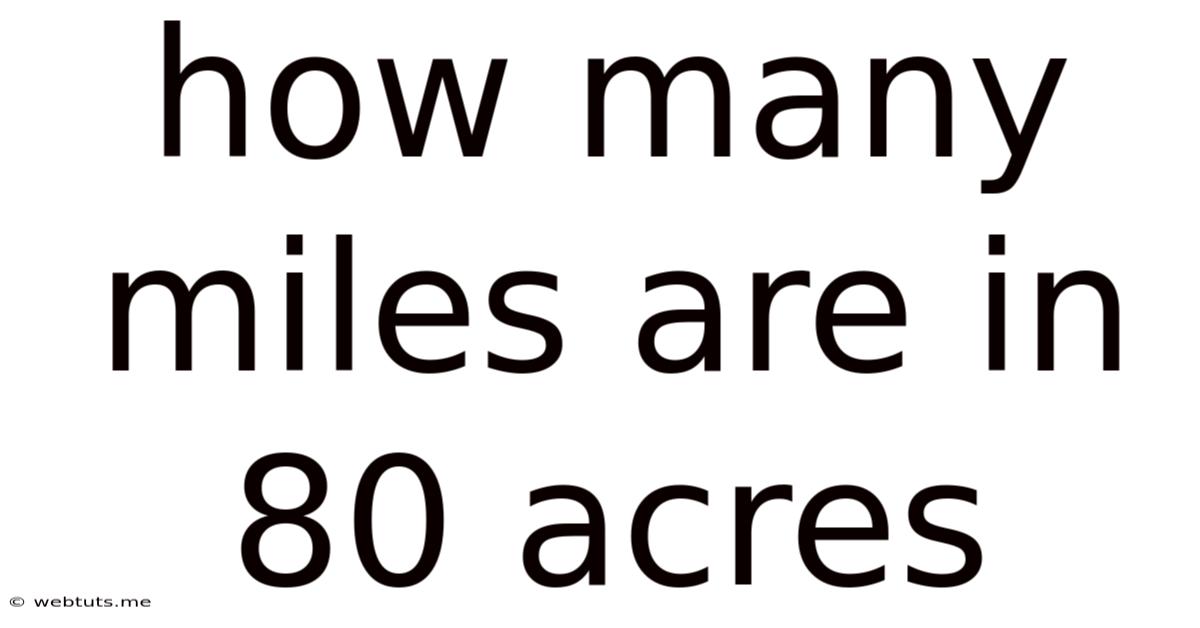How Many Miles Are In 80 Acres
Webtuts
May 12, 2025 · 4 min read

Table of Contents
How Many Miles Are in 80 Acres? Understanding Land Measurement and Conversions
The question, "How many miles are in 80 acres?" doesn't have a straightforward answer. Acres and miles measure different aspects of land: acres measure area, while miles measure distance or linear length. To understand the relationship, we need to delve into land measurement and the conversion process. This article will explore various aspects of land measurement, focusing on the differences between acres and miles, and provide different scenarios to help you understand how to approach similar calculations.
Understanding Acres and Miles: A Fundamental Difference
Acres are a unit of area, representing a measure of two-dimensional space. Think of it as the surface area of a plot of land. One acre is roughly the size of a football field (excluding the end zones). It's a unit commonly used in land surveying and real estate, particularly in countries that use the imperial system of measurement.
Miles, on the other hand, are a unit of linear distance or length. It measures a one-dimensional space – the distance between two points. You might use miles to describe the length of a road, the distance between two cities, or the perimeter of a property.
Therefore, you can't directly convert acres to miles. It's like trying to convert square feet to feet – they represent different dimensions. However, we can explore how acres relate to the dimensions of a rectangular piece of land, which then allows us to calculate distances within that land.
Calculating Dimensions from Acreage: The Rectangular Approach
Let's assume our 80 acres is a perfectly rectangular plot of land. To find out possible dimensions (and therefore, relate it to miles), we need to use the formula for the area of a rectangle:
Area = Length x Width
Since 1 acre is 43,560 square feet, 80 acres equals 80 * 43,560 = 3,484,800 square feet.
Now, we can explore different scenarios based on the shape of the rectangle:
Scenario 1: A Square Plot
If the 80-acre plot is a square, its length and width are equal. To find the side length:
√3,484,800 square feet ≈ 1866 feet
To convert this to miles, we use the conversion factor: 1 mile = 5280 feet
1866 feet / 5280 feet/mile ≈ 0.35 miles
Therefore, a square 80-acre plot would have sides of approximately 0.35 miles. The perimeter (total distance around) would be 4 * 0.35 miles = 1.4 miles.
Scenario 2: A Rectangular Plot with Varying Dimensions
Let's consider a rectangular plot where the length is twice the width. Let's represent the width as 'x'. Then the length would be '2x'. The area equation becomes:
2x * x = 3,484,800 square feet
Solving for x:
x² = 1,742,400 x ≈ 1320 feet (width) 2x ≈ 2640 feet (length)
Converting to miles:
Width: 1320 feet / 5280 feet/mile ≈ 0.25 miles Length: 2640 feet / 5280 feet/mile ≈ 0.5 miles
In this case, the rectangular plot is 0.25 miles wide and 0.5 miles long. The perimeter would be 2(0.25 miles + 0.5 miles) = 1.5 miles.
Scenario 3: Irregularly Shaped Plots
Real-world plots of land are rarely perfectly square or rectangular. They often have irregular shapes. In these cases, calculating the precise dimensions and relating them to miles becomes significantly more complex. You would likely need surveying techniques and specialized software to accurately determine the dimensions and calculate the perimeter or distances within the property.
The Importance of Surveying and Professional Expertise
The calculations above provide estimations. For accurate measurements, especially for significant land acquisitions or legal purposes, it is crucial to consult a professional land surveyor. They use advanced tools and techniques to precisely measure and map a property's boundaries, providing detailed information about its area, dimensions, and perimeter in both acres and miles (or other units as needed). This ensures accuracy and avoids potential disputes.
Beyond Simple Dimensions: Understanding Distances Within the 80 Acres
Even with the dimensions calculated, “How many miles are in 80 acres?” is still imprecise. The distance within the 80 acres depends entirely on which distance you're measuring:
- Diagonal Distance: The longest distance across the 80 acres. This would be calculated using the Pythagorean theorem for rectangular plots.
- Perimeter: The total distance around the property's boundary.
- Distance between specific points: The distance between any two designated points within the 80 acres. This will vary greatly depending on the chosen points.
Practical Applications and Conclusion
Understanding the relationship between acres and miles, though not a direct conversion, is essential for various applications, including:
- Real Estate: Estimating distances within a property for planning purposes.
- Agriculture: Calculating distances for planting, harvesting, or equipment travel.
- Construction: Planning infrastructure and determining material requirements based on distances.
- Land Management: Determining the optimal layout and utilization of land.
In conclusion, there's no single answer to "How many miles are in 80 acres?" The answer depends heavily on the shape and dimensions of the 80-acre plot. While we can make estimations for simplified scenarios, accurately determining distances requires professional surveying and consideration of the specific distance being measured within the property. Remember that acres measure area, and miles measure distance – understanding this fundamental difference is key to correctly interpreting and applying land measurements.
Latest Posts
Latest Posts
-
How Many Days Until Feb 17 2025
May 12, 2025
-
How Many Seconds Until June 14
May 12, 2025
-
30 Days After November 12 2024
May 12, 2025
-
How Many Days Ago Was December 13
May 12, 2025
-
How Many Ounces Is 1000 Milliliters
May 12, 2025
Related Post
Thank you for visiting our website which covers about How Many Miles Are In 80 Acres . We hope the information provided has been useful to you. Feel free to contact us if you have any questions or need further assistance. See you next time and don't miss to bookmark.